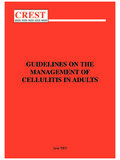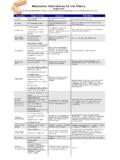Transcription of The Evaluation and Management of the Acutely Agitated ...
1 The Evaluation and Management ofthe Acutely Agitated elderly PatientDENISENASSISI, , BEATRIZKORC, , SIGRIDHAHN, , JOHNBRUNS, JR., , ANDANDYJAGODA, is an organic mental syndrome defined by a global disturbance in consciousness and cognition, which develops abruptlyand often fluctuates over the course of the day. It is precipitated by medical illness, substance intoxication/withdrawal or medica-tion is associated with significant morbidity and mortality, and is a leading presenting symptom of illness in the patients with altered mental status, including agitation, should be presumed to have delirium until proven otherwise.
2 Theclinical manifestations of delirium are highly variable. A mental status Evaluation is crucial in the diagnosis of Evaluation and stabilization should occur in parallel. Life-threatening etiologies including hypoxia, hypoglycemia andhypotension require immediate intervention. The differential diagnosis of etiologies of delirium is extensive. Patients with deliriumneed thorough evaluations to determine the underlying causes of the delirium. Pharmacological agents should be considered whenagitated patient has the potential to harm themselves or others, or is impeding medical Evaluation and Management .
3 Unfortunately,the evidence to guide pharmacologic Management of acute agitation in the elderly is limited. Current pharmacologic optionsinclude the typical and atypical antipsychotic agents and the benzodiazepines. These therapeutic options are reviewed in Words: Delirium, geriatrics, agitation, antipsychotics, Agitated elderly PATIENT poses a unique clin-ical challenge. Delirium represents a leading pre-senting symptomatology in Acutely ill elderly pa-tients. Agitation in the elderly should be presumedto be a manifestation of delirium until proven oth-erwise.
4 When mental status changes present as ag-itation, the clinician is faced with a particularlydifficult and complex scenario. A potentially im-mediately life-threatening etiology must besearched for and addressed. If agitation is severe,it requires urgent intervention to reduce potentialdanger to both patient and staff. Managing the ag-itated geriatric patient requires a coordinated ap-proach that allows the staff to gain control of thesituation while facilitating the diagnostic article will provide a framework to use whenevaluating the Agitated elderly patient, including areview of available pharmacologic population is becoming proportionately moreelderly.
5 The number of people over the age of 65 willdouble in the United States in the next 30 years (1). Asthe population ages, the elderly comprise a higher pro-portion of patients overall. This is especially true in theemergency department (ED). Persons age 65 and olderaccount for million ED visits in the annuallyand of total ED visits (2). In a multicenterstudy, patients over age 65 accounted for 43% of hos-pital admissions from the ED (3).The emergency department and acute hospitalwards have the highest rates of patients presentingwith delirium.
6 Agitation in younger patients pre-senting to the ED are much more likely to be theresult of substance abuse or underlying psychiatricdisease (psychotic or mood disorder), than in theelderly or mental status change is a leadingpresenting symptom for Acutely ill elderly ED patients over 70 years old, it has been re-ported that up to 40% have an alteration in mentalstatus, with approximately 25% diagnosed as hav-ing delirium (4). Levkoff et al. found that 24% ofelderly patients from the community and 64% ofthose presenting from nursing homes were deliri-ous upon hospital admission (5).
7 976 THEMOUNTSINAIJOURNAL OFMEDICINEVol. 73 No. 7 November 2006 From the Departments of 1 Emergency Medicine and 2 Geriatrics,Mount Sinai Hospital, Mount Sinai School of Medicine, NewYork, all correspondence and reprint requests to DeniseNassisi, , Department of Emergency Medicine, Box 1149,Mount Sinai School of Medicine, 1 Gustave L. Levy Place, NewYork, NY 10029-6574; e-mail: 73 No. 7 THE Acutely Agitated elderly PATIENT NASSISI977 Delirium is a medical emergency requiringprompt Evaluation and treatment. It is generally re-versible if the underlying cause is discovered andaddressed, and can be fatal if overlooked and un-treated.
8 Hospital mortality rates in patients withdelirium ranges from 25 33%. elderly patientswho develop delirium during hospitalization havea 22 76% chance of dying during that hospital-ization. Hospital mortality is very high in patientsthat develop delirium it is as high as the mortal-ity rate associated with acute myocardial infarctionor sepsis (6 8).Delirium: Definition and DiagnosisDelirium is an organic mental syndrome de-fined by a global disturbance in consciousness andcognition. It is characterized by a global cognitiveimpairment due to a medical condition, which de-velops abruptly and often fluctuates over the courseof the day (9).
9 The underlying mechanism of delir-ium is poorly understood and its pathophysiologyhas not been well elucidated. Delirium is commonamong medically compromised patients and the el-derly are highly vulnerable to its of delirium include disturbance inattention and memory impairment. Deficits in at-tention are characterized by ease of distractibility,with a reduced ability to focus, sustain or shift at-tention, resulting in difficulty in following com-mands. Patients may have trouble maintainingconversations, and conversations may be ramblingor incoherent.
10 Memory impairment usually in-volves recent memory; patients may be disorientedto time or place but only rarely to person. Percep-tual disturbances that may occur include misinter-pretations, illusions, or hallucinations. Often thereare alterations in the patient s sleep/wake cycle. Afluctuating course is characteristic and lucid inter-vals may be misleading (Table 1).The clinical manifestations of delirium arehighly variable. Patients with delirium may presentsubtly or dramatically. If subtle, delirium may gounrecognized without formal mental status evalua-tion.






